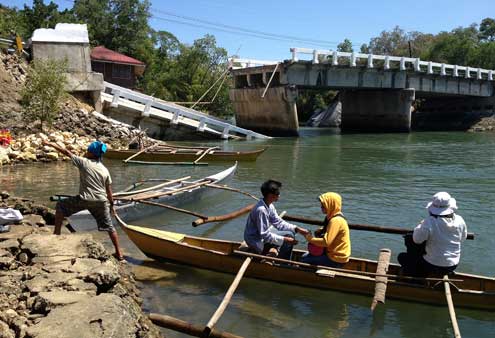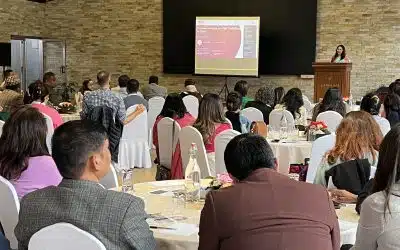InAsia
Insights and Analysis
One Year After Bohol Earthquake, Partnerships Thrive Amid Rehabilitation Efforts
October 15, 2014
One year ago today, an earthquake reported to have the energy equivalent of 32 Hiroshima bombs struck Bohol and nearby provinces in south central Philippines. Generated from a fault in the northwestern sector of Bohol Island, the earthquake registered 7.2 on the Richter scale according to the Philippine Institute of Volcanology and Seismology.
The devastation in Bohol was extensive. The National Disaster Risk Reduction and Management Council (NDRRMC) situational report indicated there were 209 deaths, 877 injured, eight missing, and a total of 1,255,128 individuals and 261,491 families affected. Bridges collapsed and there was extensive damage to historical churches, homes (71,885 total), roads, irrigation, and flood control structures. The NDRRMC estimated the cost of damage to public infrastructure at nearly $31 million. Bohol residents were left without power for several weeks.

The NDRRMC estimated the cost of damage from the Bohol earthquake to public infrastructure at nearly $31 million. Photo/Flickr user Torben Bruhn
Immediate emergency response focused on restoring communications and responding to incoming emergency calls and damage reports, emergency medical situations, search and rescue, and financial assistance to victims. Early recovery efforts, meanwhile, focused on restoring basic services, infrastructure, and livelihoods. In both of these response phases, government efforts were complemented by initiatives from the private sector, local non-government organizations, and international organizations, including shelter assistance and distribution of food packs, water, and hygiene and water sanitation kits. Social media served as an important tool for mobilizing resources and volunteers.
Less than a month after the earthquake, typhoon Yolanda (international name Haiyan) struck the same region. Though Bohol was generally spared the worst of Yolanda’s wrath, it had a strong impact on response efforts. The United Nations Office for the Coordination of Humanitarian Affairs (UNOCHA) noted that many government and international humanitarian resources were removed from Bohol to address needs caused by Yolanda. Power restoration also took longer because Bohol sources its electricity from the geothermal plant in Leyte, a province badly hit by typhoon Yolanda.
Despite the double disasters, local government, civil society, and the private sector remained committed to long-term recovery and rehabilitation. Local partnerships remained strong, a demonstration of the Filipinos’ adaptability, bayanihan (community spirit), and damayan (helping each other). The advanced state of current rehabilitation efforts in Bohol is a testament to the impact of these local partnerships.
One year on, partners are now focused on restoration of the local economy and livelihood. In a survey conducted in April 2014 by the Bohol Poll of the Holy Name University, with support from The Asia Foundation, 44 percent of respondents said that their most important problem is economic in nature such as unemployment, financial hardship, and high cost and scarcity of food. Access to public services like public works and potable water closely followed (about 24%).
One program seeking to address these issues of livelihood and economic development is the Philippines-Australia Community Assistance Program (PACAP). For example, one PACAP project is helping to cultivate sustainable agriculture livelihoods, mainly vegetable production and sawali (native bamboo slats used for walling) that can provide additional income streams for communities. This is done through partnerships among community-based organizations, non-government organizations, and local governments in Bohol.
The Asia Foundation is supporting another initiative to provide out-of-school youth with links to program interventions from various government agencies as well as with private partners who are willing to provide and support education and skills training that could eventually lead to economic and employment opportunities. This initiative, under the Foundation’s Coalitions for Change program supported by the Australian Embassy in the Philippines, partners with the provincial and municipal governments, Department of Education, and the National Youth Commission. As a result, 25,000 out of school youths have been identified in Bohol and the program has been subsequently expanded to cover the rest of the Philippines.
The earthquake also affected Bohol’s tourism industry, a strong driver of the local economy. Department of Tourism (DOT) records show tourist arrivals went down by 15 percent in the last quarter of 2013 compared to the previous year; 2014 records also show a decline of 8.5 percent to 209,634 for January to June from 229,138 in the same period last year. The United Nations World Tourism Organization, the DOT, the United States Agency for International Development under its Advancing Philippine Competitiveness Project (COMPETE), and the Pacific Asia Travel Association collaborated to develop a Bohol Tourism Recovery Plan. This plan seeks to identify strategies that will market the province to visitors from around the world, as well as develop new tourism products to strengthen Bohol’s position as an eco-cultural destination. According to the DOT, the plan aims to remove the residual fears of tourists about the viability of post-earthquake Bohol and increase resiliency among local enterprises.
Another main area of support in the rehabilitation phase is enhancing the capacities of communities and local governments to respond to and manage disaster and disaster risks. Three upcoming PACAP projects will train communities in Bohol to undertake vulnerability assessments and formulate and implement disaster management plans. These projects are consistent with the priorities of the Bohol Earthquake Action Plan prepared by the UNOCHA and the Post-Great Bohol Earthquake Rehabilitation Plan prepared by the provincial government.
With local civil society, businesses, and government partnerships thriving and bridging the recovery and rehabilitation phase, Bohol is now back on track one year after the earthquake.
Jowil Plecerda is a program officer for The Asia Foundation’s Coalitions for Change program in the Philippines. He can be reached at [email protected]. The views and opinions expressed here are those of the individual author and not those of The Asia Foundation.
About our blog, InAsia
InAsia is posted and distributed every other Wednesday evening, Pacific Time. If you have any questions, please send an email to [email protected].
Contact
For questions about InAsia, or for our cross-post and re-use policy, please send an email to [email protected].The Asia Foundation
465 California St., 9th Floor
San Francisco, CA 94104
The Latest Across Asia
News
April 2, 2024
Program Snapshot
March 28, 2024
Program Snapshot
March 28, 2024
Program Snapshot
March 25, 2024

2024 Lotus Leadership Awards
Thursday, April 25, 2024, New York City
The Lotus Leadership Awards recognize contributions towards gender equality in Asia and the Pacific







0 Comments